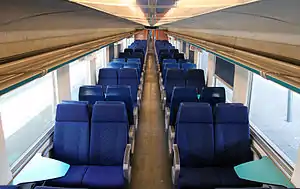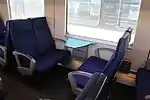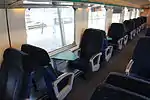Belgian Railways Class 96
The class 96 (MS96 in Dutch, AM96 in French) is an electric multiple unit constructed in 1996[2] for the National Railway Company of Belgium.
| SNCB AM96 / NMBS MS96 | |
|---|---|
.jpg.webp) Two Class 96 units at Antwerpen-Berchem | |
 Second class interior | |
| In service | 1996–present |
| Manufacturer | Bombardier Transportation |
| Built at | Bruges, Belgium[1] |
| Constructed | 1996 |
| Number built | 120 |
| Formation | Bx + B + ADx |
| Fleet numbers | 441–490 (dual-voltage), 501–570 (DC-only) |
| Capacity | 168 second class, 45 first class, 213 total |
| Operator(s) | NMBS/SNCB |
| Specifications | |
| Car length | 26,400 mm (86 ft 7 in) |
| Width | 2,860 mm (9 ft 5 in)[2] |
| Maximum speed | 160 km/h (100 mph) |
| Traction system | 441–490: 3 kV DC; 25 kV AC 501–570: 3 kV DC |
| Power output | 1,400 hp (1,000 kW) |
| UIC classification | Bo'Bo' + 2'2' + 2'2' |
| Safety system(s) | Memor, TBL 1+, KVB, ETCS |
| Coupling system | Scharfenberg |
| Track gauge | 1,435 mm (4 ft 8+1⁄2 in) |
They incorporate features from the DSB IC3 trainsets in order to enable passage from one set coach to another. When two or more units are coupled together in a single train, the entire front door folds away to give a wide passage, and the rubber diaphragms at the ends form a flush aerodynamic seal. The trainsets have air conditioning that can be controlled per coach , which makes them suitable for long distances.
As of summer 2022, these trainsets are used almost exclusively on IC connections:
- IC-03: Blankenberge - Brussels - Sint-Truiden - Genk
- IC-04: Antwerp Central - Kortrijk - Poperinge / Lille-Flandres (F)
- IC-06: Tournai - Brussels - Brussels Airport
- IC-06A: Mons - Brussels - Brussels Airport
- IC-13 Kortrijk - Zottegem - Denderleeuw - Brussels - Schaarbeek
- IC-18: Brussels - Namur - Liège-Saint-Lambert
- IC-19: Namur - Tournai - Lille-Flandres (F)
- IC-23: Ostend - Kortrijk - Zottegem - Brussels - Brussels Airport
- IC-23A: Knokke - Brussels - Brussels Airport
- IC-25: Mons - Namur - Liège-Saint-Lambert
- IC-26 Hasselt-Brussels airport- Antwerpen Central
- IC-29: Ghent - Aalst - Brussels - Brussels Airport - Landen
- IC-32: Kortrijk - Bruges (routes 805, 821, 841)
- IC-41: Namur - Charleroi - Maubeuge (F)
- IC-42: Mons - Aulnoye-Aymeries (F)
The MS96 also runs a limited number of P trains, L trains and S trains.
Versions:
There are three different variants of MS96, which can run together in train connection :
- 441-490: two-voltage motor trains; they can run on the classic Belgian railway network of 3 kV = and on the network of 25 kV~, the border lines to France and Luxembourg , theoretically also on the high-speed line from Leuven to Liège , but they are not allowed for this.
- 501-547: single-voltage motor sets; these can only run on the traditional Belgian rail network of 3 kV= and until September 2018 also on the border section Arlon - Luxembourg (501-524), also 3 kV=.
- 548-570: single-voltage motor sets; these can only run on the classic Belgian railway network of 3 kV=.
(The "classic" Belgian 3kV rail network includes all Belgian electric lines that do not cross a border with the exception of the high-speed lines and lines 42 Rivage – Gouvy, 165 Libramont – Bertrix – Athus, 166 Dinant – Bertrix and 167 Arlon – Athus – Rodange ( L), equipped with 25 kV alternating current.)
The latter two types are adaptable to 25 kV~, but since this is not necessary for most railway lines in Belgium, this investment has not yet been made. In addition, all types can run on the border section of the Liège - Maastricht route , where the Dutch overhead line voltage of 1.5 kV = 1.5 kV is used for a few kilometers. Because these trains are designed for 3 kV=, they can only run at a quarter of the capacity under the Dutch overhead lines. But since the Belgian overhead line on this route reaches Eijsden station , and there are no slopes parallel to the Maas, that is not a problem.
- Motors: 4 asynchronous motors
- At the end of 2010, the NMBS started removing the TBL 2 equipment and installing a TBL 1+ equipment.
- 2020: installation of ETCS Level 1 (also 1 LS) and Level 2
Gallery
 Cab end of a Class 96
Cab end of a Class 96.JPG.webp) NMBS/SNCB train approaching Gare de Lille Flandres.
NMBS/SNCB train approaching Gare de Lille Flandres. Two sets coupled in Gare de Lille Flandres.
Two sets coupled in Gare de Lille Flandres.
Interior
 Second class interior
Second class interior First class interior
First class interior First class interior
First class interior
Accidents and incidents
- On 5 June 2016, two units forming a passenger train were involved in a rear-end collision with a freight train at Hermalle-sous-Huy. Three people were killed and about 40 were injured.[3] Unit 548 was at the front of the train,[4] unit 461 was at the rear of the train.[5]
- On 27 November 2017, Unit 449 collided with a car on a level crossing at Morlanwelz and was damaged by the consequent fire. It was the leading unit of a train formed of units 449 and 442. During recovery operations, the unit broke free from the train and ran away, killing two people and seriously injuring two more. After travelling for 14 kilometres (8.7 mi), it collided at Strépy-Bracquegnies with a passenger train operated by two Class 96s including unit 483. Five people were injured in that collision.
References
- De Neef, David. "News on the SNCB/NMBS". Belgian Railways Unofficial website.
- "Electric Multiple AM96 – Belgium". Archived from the original on 16 June 2017. Retrieved 9 January 2015.
- "Grave accident de trains à Saint-Georges: 3 morts, 9 blessés et " une scène abominable "" [Serious train accident in Saint-Georges: 3 dead, 9 wounded and "an abominable scene"] (in French). L'Avenir. Retrieved 6 June 2016.
- "Rapport intermédiaire d'Enquête de Sécurité. Collision par rattrapage d'un train de marchandises par un train de voyageurs survenue à Hermalle-sous-Huy le 5 juin 2016" [Interim Safety Investigation Report. Rear-end collision between a freight tran and a passenger train at Hermalle-sous-Huy on 5 June 2016] (PDF) (in French). RAIIU Belgium. Retrieved 29 November 2017.
- Hartley-Parkinson, Richard. "Three dead and 40 injured after train crashes into back of freight train". Metro. Associated Newspapers Ltd. Retrieved 6 June 2016.